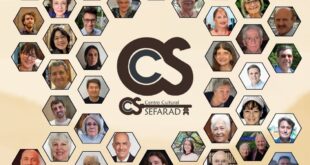
 Today Yemin Moshe is a fashionable Jerusalem neighborhood populated mainly by wealthy individuals from abroad. Despite its location in the city center, Yemin Moshe has a picturesque, country atmosphere which makes visitors feel far removed from crowded city buildings and traffic congestion. Built on many levels that are connected by stone stairs, the neighborhood is full of lush private gardens, flowering bushes, and vines.
Today Yemin Moshe is a fashionable Jerusalem neighborhood populated mainly by wealthy individuals from abroad. Despite its location in the city center, Yemin Moshe has a picturesque, country atmosphere which makes visitors feel far removed from crowded city buildings and traffic congestion. Built on many levels that are connected by stone stairs, the neighborhood is full of lush private gardens, flowering bushes, and vines.
Yemin Moshe was not always counted among the upscale, exclusive neighborhoods. It actually had very humble beginnings.
The Founding of Yemin Moshe
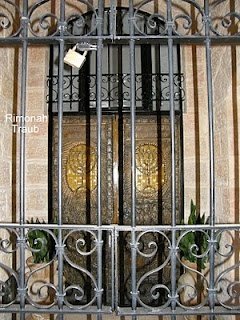 People tend to think that Mishkenot Sha’ananim and Yemin Moshe are one and the same neighborhood, but this is not the case. Although both suburbs are built on the same plot of land that Lord Moshe Montefiore bought in 1855, they are two different neighborhoods entirely. Mishkenot Sha’ananim was built in 1855, and about thirty years later, Yemin Moshe was established. Mishkenot Sha’ananim was the first suburb built outside the Old City walls, while Yemin Moshe was the thirty-seventh one to be founded in the New City of Jerusalem.
People tend to think that Mishkenot Sha’ananim and Yemin Moshe are one and the same neighborhood, but this is not the case. Although both suburbs are built on the same plot of land that Lord Moshe Montefiore bought in 1855, they are two different neighborhoods entirely. Mishkenot Sha’ananim was built in 1855, and about thirty years later, Yemin Moshe was established. Mishkenot Sha’ananim was the first suburb built outside the Old City walls, while Yemin Moshe was the thirty-seventh one to be founded in the New City of Jerusalem.
“Kerem Moshe ve Yehudis” was comprised of seventy dunam. Of this area, approximately 37 dunam were used in building Mishkenot Sha’ananim. About a year after Sir Moshe passed away in 1885, rumors began circulating that his nephew Yosef Sebag Montefiore wanted to sell the remainder of the plot to the Alliance Israelite Universelle Institution (Kyach-Kol Yisrael Chaverim) who planned to build a progressive school there.
The Old Yishuv was up in arms. How could they sell land consecrated for housing the poor, bought with money bequeathed to the impoverished of Jerusalem by the American millionaire Judah Touro? And to top it all, how could it be sold to such a questionable organization, for such a questionable cause? A large group of poor people took the law into their own hands and moved over from the Old City to squat on the property. They set up their tents and shanties in a makeshift neighborhood.
Fiery letters were sent by the Rabbonim of Yerushalayim to the younger Montefiore. The letters claimed that they were willing to dig beneath the foundation of Mishkenot Sha’ananim where Sir Moshe had deposited a document written in his own hand, stating that the land had been bought to build housing for the poor and the area was hekdesh.
The dispute reached as far as the English courts. In 1887, the court ruled that Yosef Sebag had to hand the land over to the management of the Montefiore Testimonial Fund since the land was indeed intended for the construction of housing for the indigent of Jerusalem.
“Kerem Moshe ve Yehudis” was comprised of seventy dunam. Of this area, approximately 37 dunam were used in building Mishkenot Sha’ananim. About a year after Sir Moshe passed away in 1885, rumors began circulating that his nephew Yosef Sebag Montefiore wanted to sell the remainder of the plot to the Alliance Israelite Universelle Institution (Kyach-Kol Yisrael Chaverim) who planned to build a progressive school there.
The Old Yishuv was up in arms. How could they sell land consecrated for housing the poor, bought with money bequeathed to the impoverished of Jerusalem by the American millionaire Judah Touro? And to top it all, how could it be sold to such a questionable organization, for such a questionable cause? A large group of poor people took the law into their own hands and moved over from the Old City to squat on the property. They set up their tents and shanties in a makeshift neighborhood.
Fiery letters were sent by the Rabbonim of Yerushalayim to the younger Montefiore. The letters claimed that they were willing to dig beneath the foundation of Mishkenot Sha’ananim where Sir Moshe had deposited a document written in his own hand, stating that the land had been bought to build housing for the poor and the area was hekdesh.
The dispute reached as far as the English courts. In 1887, the court ruled that Yosef Sebag had to hand the land over to the management of the Montefiore Testimonial Fund since the land was indeed intended for the construction of housing for the indigent of Jerusalem.
 The Fund now turned its attention to the illegal squatters who were living on the land. It wanted the housing to be apportioned in an orderly fashion, as had been done with Mishkenot Sha’ananim. It was their intention to evacuate the indigent families who had nowhere else to go.
The Fund now turned its attention to the illegal squatters who were living on the land. It wanted the housing to be apportioned in an orderly fashion, as had been done with Mishkenot Sha’ananim. It was their intention to evacuate the indigent families who had nowhere else to go.
This dark chapter of Jerusalem’s history is reminiscent of what happened in Gush Katif when 9,000 Jews were forcibly removed from their homes in the Gaza Strip in 2005. In the case of Yemin Moshe, here were Jews who had immigrated to Eretz Yisrael from Russia and Romania. They had no place to live, and nobody cared.
The negotiations back and forth took took many years. The end result was that the Ashkenazim in the group were moved to a colony in the Meah Shearim area opposite Batei Wittenburg, and the Sephardim were given homes near Nachlaot in the Shevet Tzedek neighborhood, nicknamed Shchunat HaPachim because the walls of these homes were covered in tin.
By 1893 the building of Yemin Moshe was completed. In memory of Moshe Montefiore, the neighborhood’s name comes from Isaiah 63:12: «. . . Who caused His splendorous arm to go on Moshe’s right side. . . “
Arab Attacks That Leave Yemin Moshe Deserted
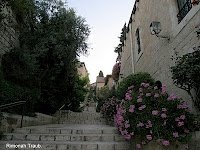 Yemin Moshe was built on a number of levels, connected to each other by steep stairways (there are 120 steps in Yemin Moshe). The long streets are paved in stone. It was built with two separate sections, one for Sephardim and one for Ashkenazimin, each with its own shul. Each family built its own home, and most of the houses were double-storied.
Yemin Moshe was built on a number of levels, connected to each other by steep stairways (there are 120 steps in Yemin Moshe). The long streets are paved in stone. It was built with two separate sections, one for Sephardim and one for Ashkenazimin, each with its own shul. Each family built its own home, and most of the houses were double-storied.
As the years passed, many of the Ashkenazi families moved out of Yemin Moshe, leaving behind a majority of Sephardi residents. Arab attacks became very frequent, necessitating the building of a wall around Yemin Moshe in 1920. People slowly started to leave the neighborhood in search of safer havens. However, on Shabbos, many of is former inhabitants returned just to pray in their shuls.
 On May 14th of 1948, the night that Israel was declared a Jewish state, Yemin Moshe was abandoned by the last of its inhabitants. During the War of Independence, the Israeli Army took over the deserted Yemin Moshe. In order to be able to maneuver troops freely the army destroyed many of the buildings. Yemin Moshe became a battlefield, and many Israeli soldiers lost their lives there.
On May 14th of 1948, the night that Israel was declared a Jewish state, Yemin Moshe was abandoned by the last of its inhabitants. During the War of Independence, the Israeli Army took over the deserted Yemin Moshe. In order to be able to maneuver troops freely the army destroyed many of the buildings. Yemin Moshe became a battlefield, and many Israeli soldiers lost their lives there.
After war’s end and during the first years of the state, there was a great wave of immigration from Turkey. The Ministry of Housing settled these olim in the abandoned houses of Yemin Moshe. The Jewish community in Turkey sent money to rebuild and restore the area.
Yemin Moshe and its Rav and Rebbetzin
Those were difficult years for the residents of Yemin Moshe. The 1948 Armistice Line turned the area into a frontier on the «no-man’s land» of a divided Jerusalem. The border between Israel and Jordan was located in the Hinnon Valley which is just below Yemin Moshe. Jordanian soldiers would sit on the Old City walls and shoot indiscriminately at the people of Yemin Moshe who were just trying to live their lives.
Born in Jerusalem, Rav Chaim Shraga Fievel Frank was the nephew of HaRav Pesach Zvi Frank and a dayan on HaRav Pesach’s Beis Din. After the 1948 War of Independence, Rav Chaim Shraga Fievel became the Rav of Yemin Moshe.
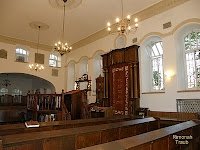 When the Rav and his family arrived, the area was a ruin from the battles that had been fought there. The homes received by the olim had to be restored to a livable condition. The shul was especially hard hit. Rav Frank, himself, renovated the building, replacing all the blown out windows and repairing whatever needed fixing. At one point, he tied two ladders together, and sent one of his young daughters up to paint the top of the aron kodesh. Every Erev Shabbos for all the years they lived in Yemin Moshe, the Rebbetzin would wash the floors of the sanctuary.
When the Rav and his family arrived, the area was a ruin from the battles that had been fought there. The homes received by the olim had to be restored to a livable condition. The shul was especially hard hit. Rav Frank, himself, renovated the building, replacing all the blown out windows and repairing whatever needed fixing. At one point, he tied two ladders together, and sent one of his young daughters up to paint the top of the aron kodesh. Every Erev Shabbos for all the years they lived in Yemin Moshe, the Rebbetzin would wash the floors of the sanctuary.
The new state settled many pitiful remnants of the Holocaust in what was then a very dilapidated neighborhood. These new immigrants were bereft of worldly possessions, except for the bare minimum given by the Misrad HaKlita. Not only were they impoverished, but they were severely traumatized by their experiences in Europe
Rav Frank and his wife Rochel Leah were an anchor and stabilizing force for these people. Since there were no social services at the time, the Frank’s home became the address for receiving help, whether it was physical, spiritual, or psychological. Here, the orphaned, the childless, and the widowed all found solace.
The Rav was their posek as well as being the shepherd of these battered souls who numbered around seventy families and individuals. People needing loans knew they could come to the Rav. At all the Shabbos meals, the house was pulsating with guests, many of them inhabitants of Yemin Moshe who did not have what to eat at home.
Yemin Moshe Simchas Catered by Rebbetzin Frank
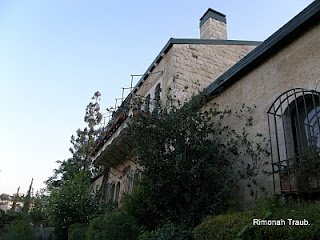 The large kiddush held in the shul every week was catered solely by Rebbetzin Rochel Leah. On the Seder night the five meter long table was packed with literally no place to move. Many times chuppahs were set up in the courtyard of the Franks’ home. The Rav would be Me’sader Kiddushin, while his wife cooked the seudah for all the guests. Likewise, brissim and bar mizvahs were held in their home.
The large kiddush held in the shul every week was catered solely by Rebbetzin Rochel Leah. On the Seder night the five meter long table was packed with literally no place to move. Many times chuppahs were set up in the courtyard of the Franks’ home. The Rav would be Me’sader Kiddushin, while his wife cooked the seudah for all the guests. Likewise, brissim and bar mizvahs were held in their home.
It was not like today when you can buy ready made food, or at least purchase the ingredients in stores. The Rebbetzin had to make everything from scratch, starting with noodles for the yerushalmie kugel to the pickles served as a garnish to go with it. Since there were no proper shops in Yemin Moshe, she bought everything (even candles and milk) in the Meah Shearim market and shlepped the huge quantities home in large baskets.
The Rebbetzin’s high, fluffy cakes were legendary. Made with only four eggs beaten with two forks and baked in a wonder pot over a primus flame, they rose high above the deep walls of the wonder pot, pushing off the lid. Each cake could be cut crosswise in half, yielding two very respectable cakes.
Father to Holocaust Orphans
At that time, there was a hostel in Yemin Moshe called Knesses Bnai HaGolah, for homeless boys, mostly Holocaust survivors. Rav Frank was like a father to these young orphans. Some of them had reached the age of fourteen and had not learned to read since they had spent the terrible war years hiding in the forests, surviving day by agonizing day.
The Rav started by teaching them basic Alef Beis. He encouraged them forward to the study of Mishnayos, then Gemara, until they reached a level in their learning that they could enter the finest yeshivas. These boys eventually became talmidei chachamim, married, and established Jewish homes. They had children, and now with the help of HaShem, they have grandchildren and great-grandchildren, which is the best revenge that they could take on Hitler, yemach shemo.
Two young boys lived in the storage room under the Franks’ home. One day one of these teenagers came to the Rav and wanted to show him something. The boy of maybe fifteen at the most, took out of his pocket something wrapped in a little cloth. He unwrapped the cloth, and inside was a piece of what looked like a piece of soap. On it was written the German words Juden Riener Shmaltz, “Pure Jewish Fat.”
 The inhabitants of Yemin Moshe continued to be the targets of Jordanian Legionaries who fired on them from the walls of the Old City. Added to that constant danger were the other hardships of the early years of the state like the need for rationing food. Yet the Rav and the Rebbetzin were a tower of strength for the people of Yemin Moshe whom they helped in facing the past, building new lives in the present, and making a future for themselves.
The inhabitants of Yemin Moshe continued to be the targets of Jordanian Legionaries who fired on them from the walls of the Old City. Added to that constant danger were the other hardships of the early years of the state like the need for rationing food. Yet the Rav and the Rebbetzin were a tower of strength for the people of Yemin Moshe whom they helped in facing the past, building new lives in the present, and making a future for themselves.
Yemin Moshe after the Six Day War
Following the lightning and miraculous Six Day War, the government decided that Yemin Moshe was the perfect place for an artist’s colony. Most of Rav Frank’s community was moved out of the neighborhood, but Rav Frank stayed on. Often there was no minyan in his shul, and the Rav’s grandchildren would come to complete the quorum. Sometimes bochurim from Rav Goldstein’s Diaspora Yeshiva where Rav Frank taught or Yeshivas Orloi in Katamon would come to join the minyan.
Rebbetzin Rochel Leah would leave her home in Yemin Moshe at two-thirty each and every morning to reach the Kosel for Neitz. She carried a lantern and a large stock of candles. As she walked along, she would deposit lit candles in stone nooks and crannies along her path, so that those coming after her should have light. She walked though Shaar Tzion and the Arab Shuk to reach the Kosel. On Shabbos she took with her the kosher parchment Navie being read that week form the Shul of Yemin Moshe so it could be read by a number of minyanim at the Wall. She would then return it to the Yemin Moshe Shul in time for Shachris . Bringing the Navie to and from the Kosel, was not an easy task as it had to be protected well, from all weather elements including heavy rains. Eventually the Franks donated a set of parchment Nevim to the Kosel. Till today they are found there in the special Aron Kodesh on the Franks names. Their velvet mantels proudly display the names of Rav Chaim Shraga Fievel and Rebbetzin Rochel-Leah Frank.
No matter the weather – rain, snow, sleet or heat -, Rebbetzin Frank always went to the Kosel for Neitz. One Seder night, two years before her passing, when Rav and Rebbetzin Frank were hosted by their daughter who lives in Shicun HaRabbanin,( which is at the far end of Geulah,) the Rebbetzin set out right after the Seder towards the Kosel.
In 1983, Rebbetzin Rochel Leah suffered a heart attack at the Kosel on Erev Rosh Hashanah and passed away the next day. Rav Frank passed away two and a half months later on Yud Zayin Kislev at the age of sixty-four.
Yemin Moshe Today
Appearing much the same as it did at the turn of the century, Yemin Moshe is largely inhabited by wealthy people from abroad who keep residences here as holiday homes. During the off-season, the neighborhood is mostly deserted, but the greenery and gardens make it a perfect destination for an outing. It also features stunning views of the Old City and a small museum dedicated to the accomplishments of Moshe Montefiore in building the New City of Jerusalem.
The author would like to thank Rebbetzin M.Rosental for the information she provided about her parents, Rav and Rebbetzin Frank.

By Vardah Littmann
Photos by Rimonah Traub
Published in the «English Update» 27 January 2011
Fuente:Let us tour Eretz Israel
 eSefarad Noticias del Mundo Sefaradi
eSefarad Noticias del Mundo Sefaradi

